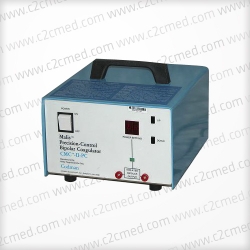The ValleyLab Force FX with instant response technology provides surgeons with improved performance at lower power settings, minimizing the risk of tissue damage and neuromuscular stimulation, and decreasing the need to “turn up the generator.”
ValleyLab Force FX
Product Description
The ValleyLab Force FX with instant response technology provides surgeons with improved performance at lower power settings, minimizing the risk of tissue damage and neuromuscular stimulation, and decreasing the need to “turn up the generator.”
A Smoother Cut Through All Tissue Types
The Force FX generator adjusts automatically, responding to tissue changes, maintaining power delivery, and minimizing drag.
Added Safety and Reliability Minimizes Electrosurgical Risks
Capacitive coupling is reduced by 30-50% when using Instant Response technology. This reduction is achieved by limiting the RMS voltage and the high frequency harmonics. Lower voltage means less neuromuscular stimulation and more precise delivery of energy to reduce collateral damage.
What is Instant Response Technology?
Instant Response technology features an advanced feedback system that recognizes changes in tissue 200 times per second, and adjusts voltage and current accordingly to maintain appropriate power. This unique capability differentiates Instant Response™ generators from any other, as shown by their high power efficiency rating (PER). That’s smart™ generator technology.
PER indicates the ability of a generator to accurately deliver the selected power into a wide range of tissue types. With a PER of 98, the Force FX generator provides a consistent surgical effect and has a higher PER than any other electrosurgical generator.
Instant Response Technology provides consistent power through different tissue types.
The Force FX generator provides surgeons with the advantage of accurately delivering the selected power setting, even through resistant tissue.
When a conventional generator encounters tissue changes, both power delivery and cutting efficiency are reduced. This means that higher power settings are required in order to cut through all types of tissue. With higher power settings, more energy is delivered, and tissue damage increases.
FEATURES
Instant Response technology ensures that the power delivered remains virtually constant, regardless of the tissue type
Improved performance at lower power settings minimizes the risk of tissue damage and neuromuscular stimulation
Three internal microcontrollers reduce system reaction time and increase the system’s processing speed
Spray coagulation voltage of no more than 9000 volts peak-to-peak output for broad, but superficial coagulation with limited capacitive coupling
A Power Efficiency Rating (PER) of approximately 98 for accurate and consistent cut performance
Three cut modes, all controlled by Instant Response™ technology, offer surgeons a variety of choices
Low Cut for delicate tissue or laparoscopic cases
Pure Cut for a clean, precise cut
Blend for cutting with hemostasis
Four coag modes
Desiccate for low voltage contact coagulation suitable in laparoscopic and delicate tissue work
Fulgurate (high crest factor) for efficient noncontact coagulation in most applications
Fulgurate (low crest factor) for lower voltage coagulation requirements
Spray for coagulating large tissue areas with superficial depth of necrosis
Three bipolar modes
Precise, Standard, and Macrobipolar are controlled by the Instant Response™ system
Precise and Standard setting utilize low voltage to prevent sparking
Versatile system that is uniquely compatible with other devices, including:
Force Argon II and Force GSU argon coagulation system
CUSA EXcel and CUSA 200 ultrasonic surgical aspirators
OptiMumm smoke evacuator, through a direct cable link
Valleylab VLCM bipolar current monitor
Compatible with and used as the electrosurgical energy source for:
Dyonics Control RF arthroscopic ablation system
Dyonics Electroblade rotary resection system
Cook Vascular Perfecta EDS pacemaker lead extraction system
Compatible with, and the exclusive electrosurgical generator for, the Computer Motion Hermes Voice Command System
TECHNICAL SPECIFICATIONS (110-120V)
Output Waveforms
Bipolar
Precise: 470 kHz sinusoid
Standard: 470 kHz sinusoid
Macro: 470 kHz sinusoid
Monopolar Cut
Low: 390 kHz sinusoid. Similar to the Pure Cut mode except the maximum voltage is limited to a lower value.
Pure: 390 kHz sinusoid
Blend: 390 kHz bursts of sinusoid, recurring at 27 kHz intervals. 50% duty cycle envelope.
Monopolar Coag
Desiccate: 240 kHz sinusoid repeated at 39 kHz. 8% duty cycle.
Fulgurate: 390 kHz damped sinusoid bursts with a repetition frequency of 30 or 57 kHz into 500 ohms
Spray: 390 kHz damped sinusoidal bursts with a randomized repetition centered at 28 kHz. Frequencies include 21 kHz
Output power changes by less than 15% or 5 watts, whichever is greater, as the line voltage varies from 104-132 volts and 208-264 volts (at rated load).
Low Frequency Leakage (50-60 Hz)
Source current, patient leads, all outputs tied together
Normal polarity, intact chassis ground: <10 µA Normal polarity, ground open: < 50 µA Reverse polarity, ground open: < 50 µA Sink current, 140V applied, all inputs: < 50 µA PER = 98 PER (Power Efficiency Rating) is the measure of an electrosurgical generator’s ability to accurately deliver the selected power into a wide range of tissue types. Weight and Dimensions Height: 11.1 cm (4-3/8 in.) Width: 35.6 cm (14 in.) Length: 43.9 cm (17 in.) Weight: < 8.1 kg (<18 lbs) Input Power Requirements Operating range is 85 to 132 AC volts. Maximum current is 7 amperes in Cut and 4 amperes in Coag. High Frequency Leakage Bipolar: Less than 60 mA (rms) Monopolar: Less than 150 mA (rms) REM Contact Quality Monitoring System Measurement Frequency: 80 kHz ± 10 kHz Measurement Current: Less than 10 µA Acceptable Resistance Ranges: REM pad – 5-135 ohms Non-REM™ pad – less than 20 ohms Acceptance range is 5-135 ohms after REM PolyHesive II return electrode is applied. Adaptive REM. REM™ trip is baseline impedance plus 40%. For example, if the baseline impedance is 30 ohms, the upper level trip approximately 42 ohms. If the pad-patient impedance falls below the baseline impedance, a new baseline is established. Output Characteristics. Bipolar Precise Mode: Maximum P-P Voltage: 450 Rated Load (OHMS): 100 Maximum Power (Watts): 70 Crest Factor (Typical): 1.5 Standard Mode: Maximum P-P Voltage: 320 Rated Load (OHMS): 100 Maximum Power (Watts): 70 Crest Factor (Typical): 1.5 Macro Mode: Maximum P-P Voltage: 750 Rated Load (OHMS): 100 Maximum Power (Watts): 70 Crest Factor (Typical): 1.5 Monopolar Cut Low Mode: Maximum P-P Voltage: 1350 Rated Load (OHMS): 300 Maximum Power (Watts): 300 Crest Factor (Typical): 1.5 Pure Mode: Maximum P-P Voltage: 2300 Rated Load (OHMS): 300 Maximum Power (Watts): 300 Crest Factor (Typical): 1.5 Blend Mode: Maximum P-P Voltage: 3300 Rated Load (OHMS): 300 Maximum Power (Watts): 200 Crest Factor (Typical): 2.5 Monopolar Coag Desiccate Mode: Maximum P-P Voltage: 3500 Rated Load (OHMS): 500 Maximum Power (Watts): 120 Crest Factor (Typical): 5 Fulg. High Crest Factor* Mode: Maximum P-P Voltage: 8500 Rated Load (OHMS): 500 Maximum Power (Watts): 120 Crest Factor (Typical): 7.0 Fulg. Low Crest Factor *Mode: Maximum P-P Voltage: 6900 Rated Load (OHMS): 500 Maximum Power (Watts): 120 Crest Factor (Typical): 5.5 Spray Mode: Maximum P-P Voltage: 9000 Rated Load (OHMS): 500 Maximum Power (Watts): 120 Crest Factor (Typical): 8 CEM Mode Monopolar Cut (Low): Maximum P-P Voltage: 1000 Rated Load (OHMS): 300 Maximum Power (Watts): 100 Crest Factor (Typical): 1.5 Monopolar Coag (Dessicate): Maximum P-P Voltage: 3500 Rated Load (OHMS): 500 Maximum Power (Watts): 70 Crest Factor (Typical): 5





